iOS
最后更新时间:2025-09-11 10:06:06
业务流程
本节汇总了语聊房中一些常见的业务流程,帮助您更好地理解整个场景的实现流程。
下图展示了房间管理流程,包含创建、加入、退出、解散房间的实现流程。
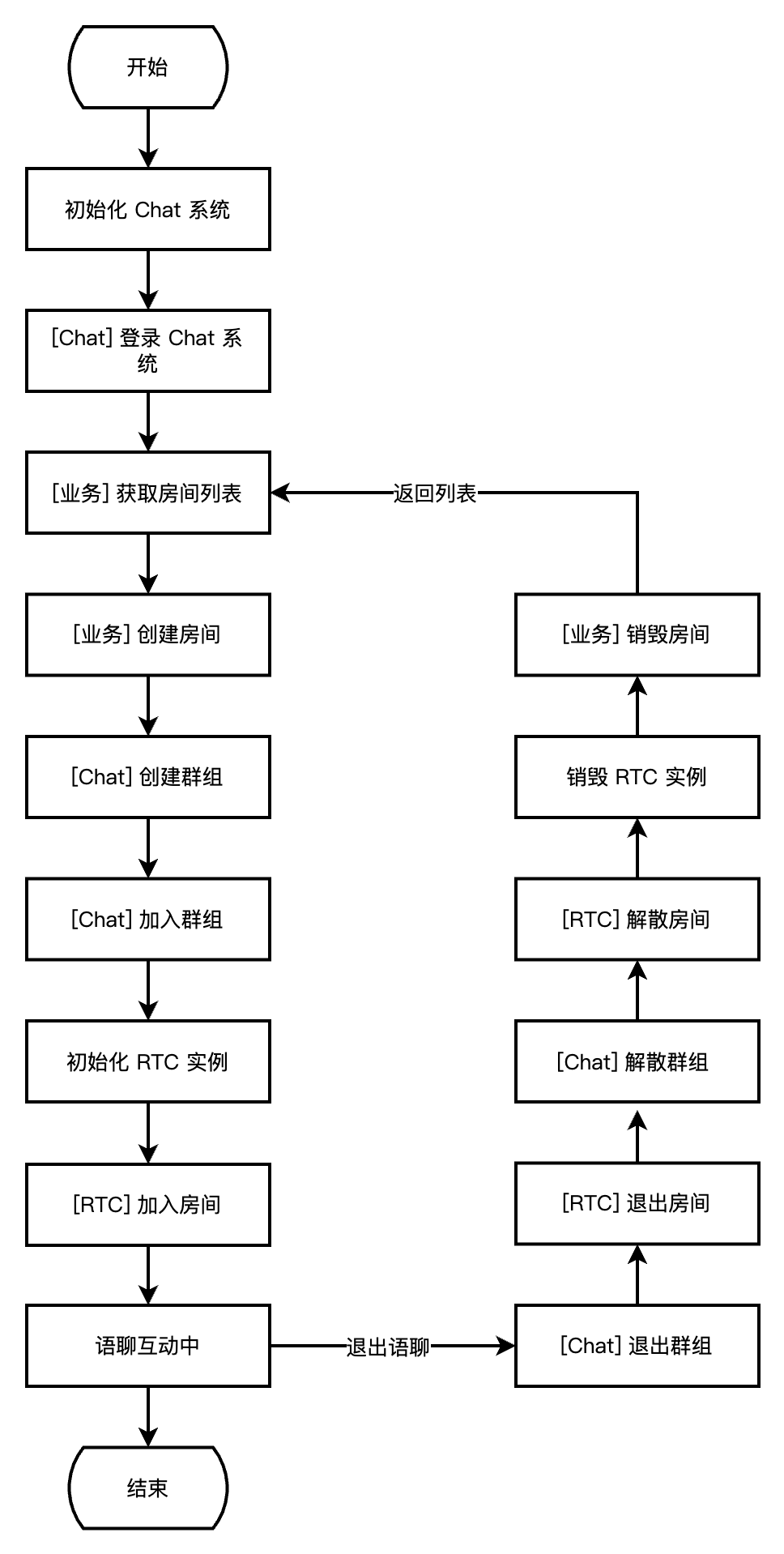

下图展示了房主麦位管理流程,包含抱人上麦、踢人下麦、麦位禁音的实现流程。
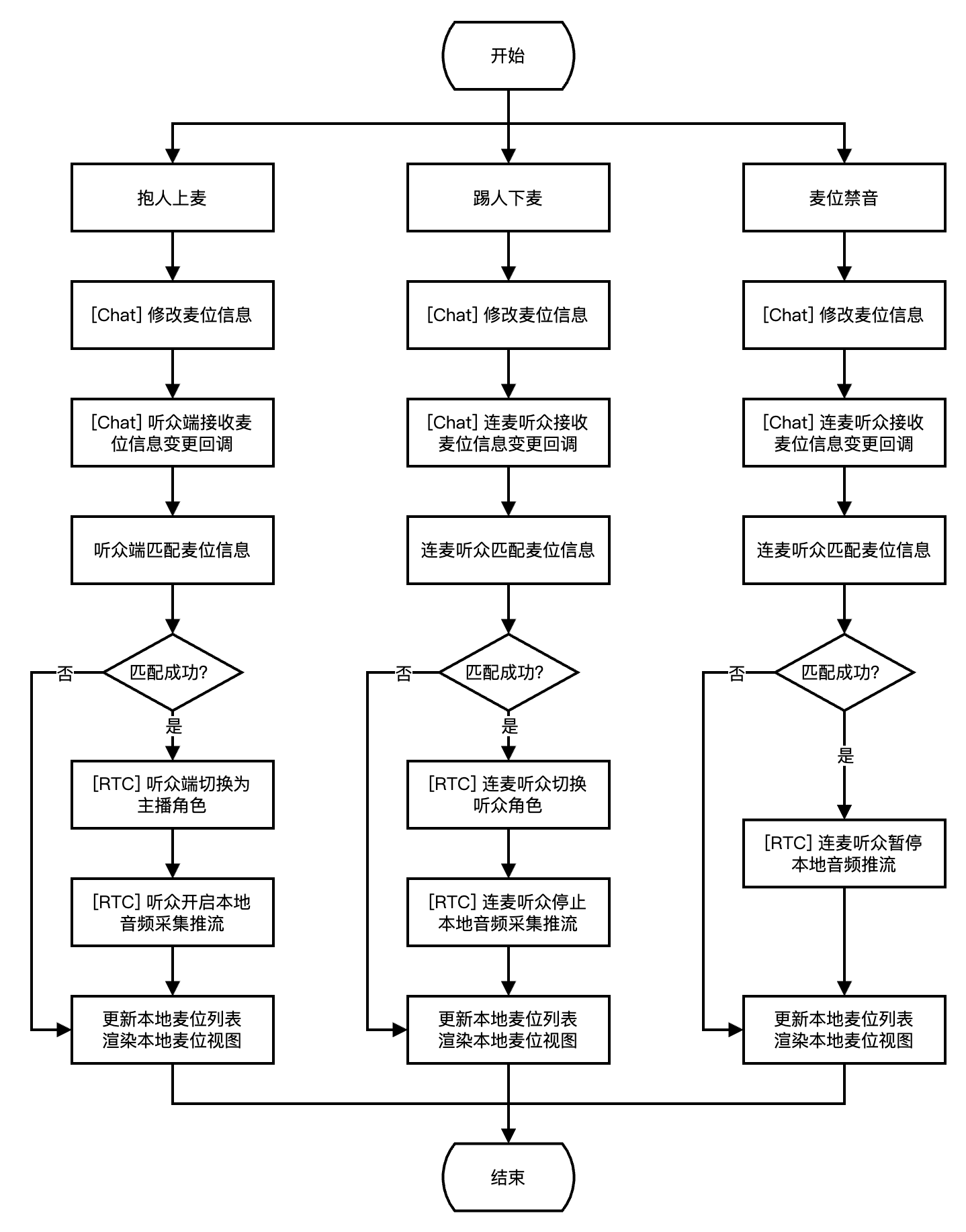

下图展示了听众麦位管理流程,包含主动上麦、主动下麦、麦位移动的实现流程。
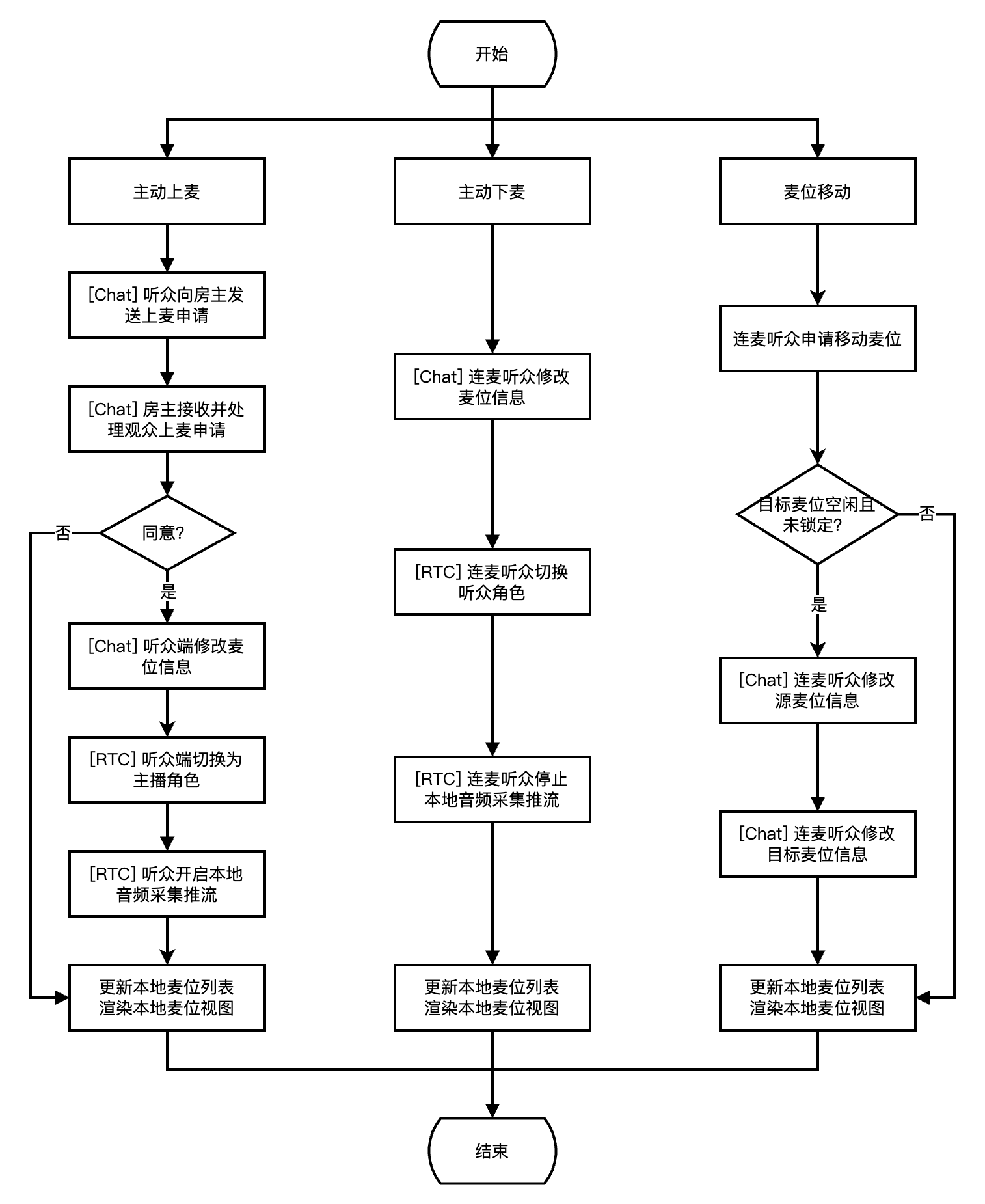

接入准备
步骤一:开通服务
1. 首先您需要登录 控制台 创建应用,创建一个 RTC Engine 的应用,然后再创建一个Chat 应用。
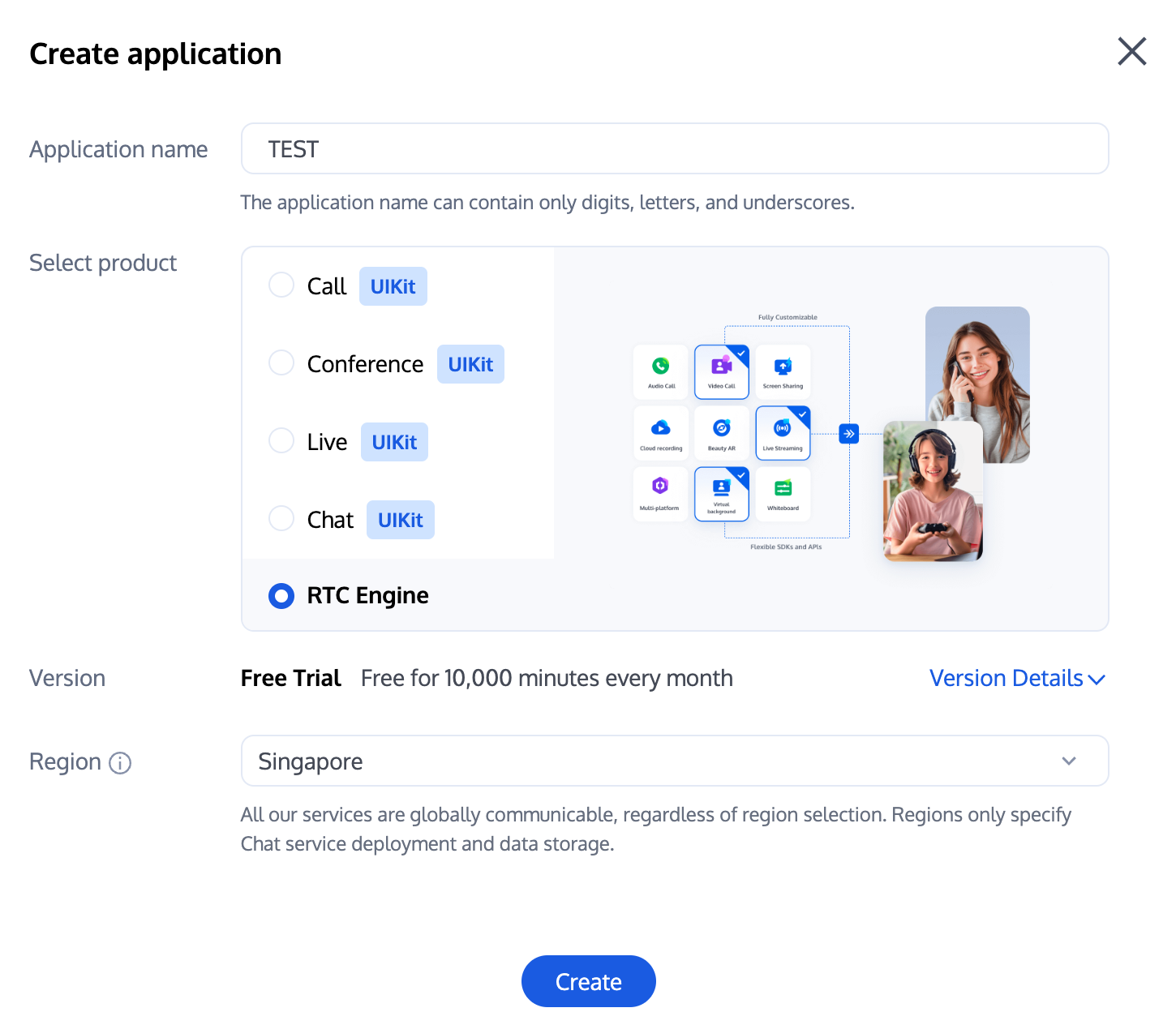

说明:
建议创建两个应用分别用于测试环境和生产环境,一年内每个账号(UIN)每月赠送10,000分钟免费时长。
RTC Engine 包月套餐分为体验版(默认)、轻量版、标准版、专业版,可解锁不同的增值功能服务,详情可见 版本功能与包月套餐说明。
2. 创建应用完毕之后,您可以在应用管理-应用概览栏目看到该应用的基本信息,其中需要您保管好 SDKAppID、SDKSecretKey 便于后续使用,同时应避免密钥泄露造成流量盗刷。


步骤二:导入 SDK
RTC Engine SDK 和 Chat SDK 已经发布到 CocoaPods,建议您通过 CocoaPods 集成 SDK。
1. 安装 CocoaPods。
在终端窗口中输入如下命令(需要提前在 Mac 中安装 Ruby 环境):
sudo gem install cocoapods
2. 创建 Podfile 文件。
进入项目所在路径,输入以下命令行之后项目路径下会出现一个 Podfile 文件。
pod init
3. 编辑 Podfile 文件。
根据您的项目需要选择合适的版本,并编辑 Podfile 文件。
platform :ios, '8.0'target 'App' do# TRTC 精简版# 安装包体积增量最小,仅支持 RTC Engine 和 直播播放器(TXLivePlayer)两项功能。pod 'TXLiteAVSDK_TRTC', :podspec => 'https://liteav.sdk.qcloud.com/pod/liteavsdkspec/TXLiteAVSDK_TRTC.podspec'# Add the Chat SDKpod 'TXIMSDK_Plus_iOS'# pod 'TXIMSDK_Plus_iOS_XCFramework'# pod 'TXIMSDK_Plus_Swift_iOS_XCFramework'# If you need to add the Quic plugin, please uncomment the next line.# Note: This plugin must be used with the Objective-C edition or XCFramework edition of the Chat SDK, and the plugin version number must match the Chat SDK version number.# pod 'TXIMSDK_Plus_QuicPlugin'end
4. 更新并安装 SDK。
在终端窗口中输入如下命令以更新本地库文件,并安装 SDK。
pod install
或使用以下命令更新本地库版本。
pod update
pod 命令执行完后,会生成集成了 SDK 的 .xcworkspace 后缀的工程文件,双击打开即可。
说明:
若 pod 搜索失败,建议尝试更新 pod 的本地 repo 缓存。更新命令如下。
pod setuppod repo updaterm ~/Library/Caches/CocoaPods/search_index.json
除了 CocoaPods 集成方式,您还可以选择下载 SDK 并手动导入,详见 手动集成 RTC Engine SDK 和 手动集成 Chat SDK。
Quic 插件,提供 axp-quic 多路传输协议,弱网抗性更优,网络丢包率达到 70% 的条件下,仍然可以提供服务。仅对专业版、专业版 plus 和企业版用户开放,请 购买专业版 、专业版 plus 或企业版 后可使用。为确保功能正常使用,请将终端 SDK 更新至7.7.5282及其以上的版本。
步骤三:工程配置
1. 语聊场景下 RTC Engine SDK 及 Chat SDK 需要 App 授权麦克风权限,在 App 的 Info.plist 中添加以下内容,对应麦克风在系统弹出授权对话框时的提示信息:
Privacy - Microphone Usage Description, 同时填入麦克风使用目的提示语
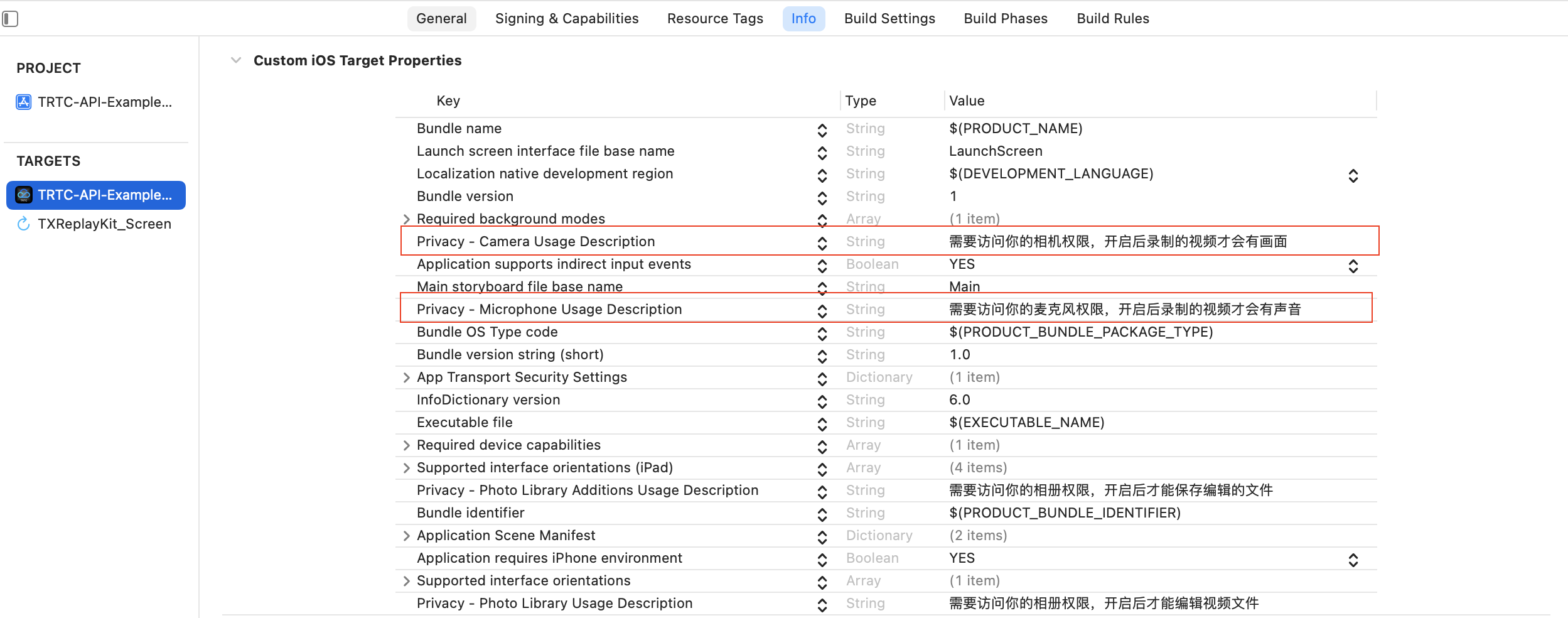

2. 如需 App 进入后台仍然运行相关功能,可在 Xcode 中选中当前工程项目,并在 Capabilities 下将设置项 Background Modes 设定为 ON,并勾选 Audio,AirPlay and Picture in Picture,如下图所示:
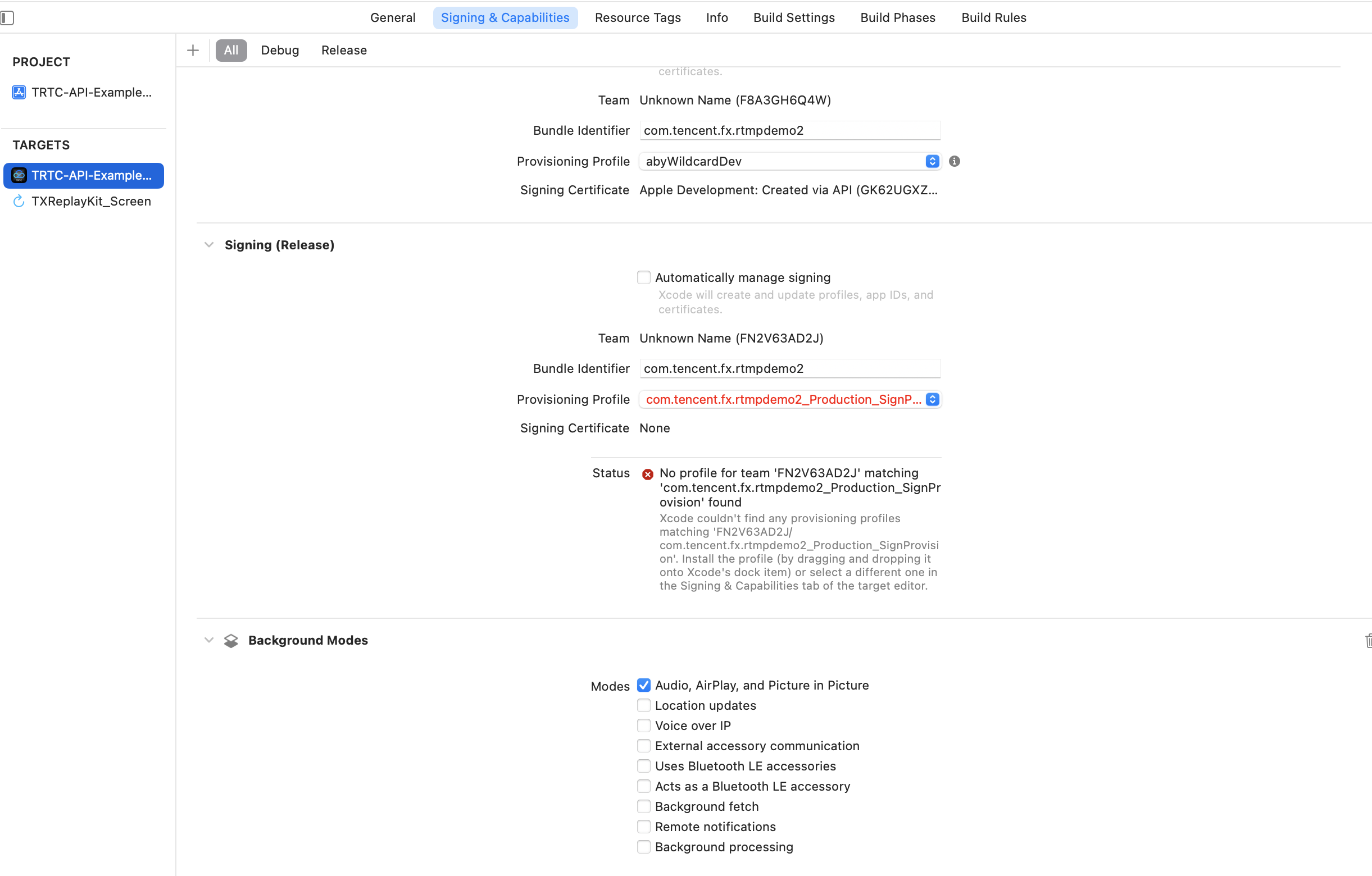

接入过程
步骤一:生成鉴权凭证
UserSig 是腾讯实时通信服务设计的一种安全保护签名,目的是为了阻止恶意攻击者盗用您的云服务使用权。RTC Engine、Chat 服务都采用了该套安全保护机制,RTC Engine 在进房时鉴权,Chat 在登录时鉴权。
正式运行阶段:推荐安全等级更高的服务端计算 UserSig 方案,防止客户端被逆向破解泄露密钥。
具体实现流程如下:
1. 您的 App 在调用 SDK 的初始化函数之前,首先要向您的服务器请求 UserSig。
2. 您的服务器根据 SDKAppID 和 UserID 计算 UserSig。
3. 服务器将计算好的 UserSig 返回给您的 App。
4. 您的 App 将获得的 UserSig 通过特定 API 传递给 SDK。
5. SDK 将 SDKAppID + UserID + UserSig 提交给腾讯云服务器进行校验。
6. 腾讯云校验 UserSig,确认合法性。
7. 校验通过后,会向 Chat SDK 提供即时通信服务、RTC Engine SDK 提供实时音视频服务。
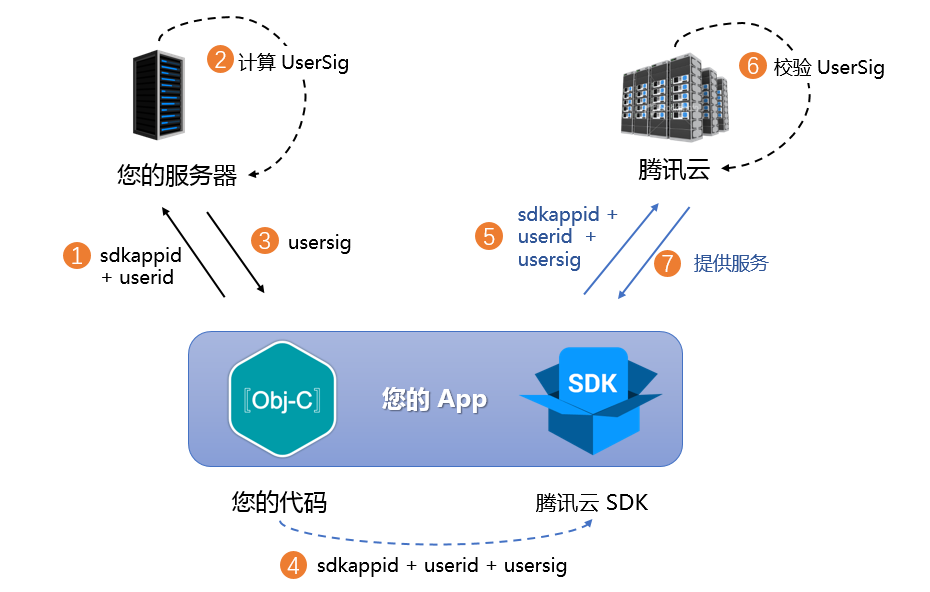

注意:
调试跑通阶段的本地 UserSig 计算方式不推荐应用到线上环境,容易被逆向破解导致密钥泄露。
我们提供了多个语言版本(Java/Go/PHP/Nodejs/Python/C#/C++)的 UserSig 服务端计算源代码,详见 服务端计算 UserSig。
步骤二:初始化与监听
时序图

1. Chat SDK 初始化与添加事件监听器。
// 从Chat 控制台获取应用 SDKAppID。// 添加 V2TIMSDKListener 的事件监听器,self 是 id<V2TIMSDKListener> 的实现类,如果您不需要监听 Chat SDK 的事件,这个步骤可以忽略。[[V2TIMManager sharedInstance] addIMSDKListener:self];// 初始化 Chat SDK,调用这个接口后,可以立即调用登录接口。[[V2TIMManager sharedInstance] initSDK:sdkAppID config:config];// SDK 初始化后会抛出一些事件,例如连接状态、登录票据过期等- (void)onConnecting {NSLog(@"Chat SDK 正在连接到腾讯云服务器");}- (void)onConnectSuccess {NSLog(@"Chat SDK 已经成功连接到腾讯云服务器");}// 移除事件监听器// self 是 id<V2TIMSDKListener> 的实现类[[V2TIMManager sharedInstance] removeIMSDKListener:self];// 反初始化 SDK[[V2TIMManager sharedInstance] unInitSDK];
说明:
如果您的应用生命周期跟 SDK 生命周期一致,退出应用前可以不进行反初始化。若您只在进入特定界面后才初始化 SDK,退出界面后不再使用,可以对 SDK 进行反初始化。
2. RTC Engine SDK 创建实例与设置事件监听器。
// 创建 RTC Engine SDK 实例(单例模式)_trtcCloud = [TRTCCloud sharedInstance];// 设置事件监听器_trtcCloud.delegate = self;// 来自 SDK 的各类事件通知(比如:错误码,警告码,音视频状态参数等)- (void)onError:(TXLiteAVError)errCode errMsg:(nullable NSString *)errMsg extInfo:(nullable NSDictionary *)extInfo {NSLog(@"%d: %@", errCode, errMsg);}- (void)onWarning:(TXLiteAVWarning)warningCode warningMsg:(nullable NSString *)warningMsg extInfo:(nullable NSDictionary *)extInfo {NSLog(@"%d: %@", warningCode, warningMsg);}// 移除事件监听器_trtcCloud.delegate = nil;// 销毁 RTC Engine SDK 实例(单例模式)[TRTCCloud destroySharedIntance];
说明:
步骤三:登录与登出
初始化 Chat SDK 后,您需要调用 SDK 登录接口验证账号身份,获得账号的功能使用权限。因此在使用其他功能之前,请务必确保登录成功,否则可能导致功能异常或不可用。如您仅需使用 RTC Engine 音视频服务,可忽略此步骤。
时序图

1. 登录。
// 登录:userID 可自定义,userSig 参考步骤一生成获取[[V2TIMManager sharedInstance] login:userID userSig:userSig succ:^{NSLog(@"success");} fail:^(int code, NSString *desc) {// 如果返回以下错误码,表示使用 UserSig 已过期,请您使用新签发的 UserSig 进行再次登录。// 1. ERR_USER_SIG_EXPIRED(6206)// 2. ERR_SVR_ACCOUNT_USERSIG_EXPIRED(70001)// 注意:其他的错误码,请不要在这里调用登录接口,避免 Chat SDK 登录进入死循环。NSLog(@"failure, code:%d, desc:%@", code, desc);}];
2. 登出
// 登出[[V2TIMManager sharedInstance] logout:^{NSLog(@"success");} fail:^(int code, NSString *desc) {NSLog(@"failure, code:%d, desc:%@", code, desc);}];
说明:
如果您的应用生命周期跟 Chat SDK 生命周期一致,退出应用前可以不登出。若您只在进入特定界面后才使用 Chat SDK,退出界面后不再使用,可以进行登出操作和对 Chat SDK 进行反初始化。
步骤四:房间管理
时序图

1. 创建房间。
// 创建群组[[V2TIMManager sharedInstance] createGroup:GroupType_AVChatRoom groupID:groupID groupName:groupName succ:^(NSString *groupID) {// 创建群组成功} fail:^(int code, NSString *desc) {// 创建群组失败}];// 监听群组创建通知[[V2TIMManager sharedInstance] addGroupListener:self];- (void)onGroupCreated:(NSString *)groupID {// 群创建回调,groupID 为新创建群组的 ID}
注意:
语聊房场景创建 Chat 群组需要选用直播群类型:
GroupType_AVChatRoom。RTC Engine 没有创建房间的 API,当用户要加入的房间不存在时,后台会自动创建一个房间。
2. 加入房间。
加入 Chat 群组。
// 加入群组[[V2TIMManager sharedInstance] joinGroup:groupID msg:message succ:^{// 加入群组成功} fail:^(int code, NSString *desc) {// 加入群组失败}];// 监听加入群组事件[[V2TIMManager sharedInstance] addGroupListener:self];- (void)onMemberEnter:(NSString *)groupID memberList:(NSArray<V2TIMGroupMemberInfo *>*)memberList {// 有人加入群组}
加入 RTC Engine 房间。
- (void)enterRoomWithRoomId:(NSString *)roomId userID:(NSString *)userId {TRTCParams *params = [[TRTCParams alloc] init];// 以字符串房间号为例,建议和 Chat 群组号保持一致params.strRoomId = roomId;params.userId = userId;// 从业务后台获取到的 UserSigparams.userSig = getUserSig(userId);// 替换成您的 SDKAppIDparams.sdkAppId = SDKAppID;// 语聊互动场景进房需指定用户角色params.role = TRTCRoleAudience;// 以语聊互动进房场景为例[self.trtcCloud enterRoom:params appScene:TRTCAppSceneVoiceChatRoom];}// 进房结果事件回调- (void)onEnterRoom:(NSInteger)result {if (result > 0) {// result 代表加入房间所消耗的时间(毫秒)[self toastTip:@"Enter room succeed!"];} else {// result 代表进房失败的错误码[self toastTip:@"Enter room failed!"];}}
注意:
RTC Engine 房间号分为整型
roomId 和字符串类型 strRoomId,两种类型的房间不互通,建议统一房间号类型。语聊互动场景进房时须指定用户角色(主播/观众),只有主播才有推流权限,如未指定则默认为主播角色。
语聊互动进房场景建议选用
TRTCAppSceneVoiceChatRoom。 3. 退出房间。
退出 Chat 群组。
[[V2TIMManager sharedInstance] quitGroup:groupID succ:^{// 退出群组成功} fail:^(int code, NSString *desc) {// 退出群组失败}];[[V2TIMManager sharedInstance] addGroupListener:self];- (void)onMemberLeave:(NSString *)groupID member:(V2TIMGroupMemberInfo *)member {// 群成员离开回调}
注意:
直播群(AVChatRoom)中,群主是不可以退群的,群主只能调用
dismissGroup 解散群组。退出 RTC Engine 房间。
- (void)exitTrtcRoom {self.trtcCloud = [TRTCCloud sharedInstance];[self.trtcCloud stopLocalAudio];[self.trtcCloud exitRoom];}// 监听 onExitRoom 回调即可获知自己的退房原因- (void)onExitRoom:(NSInteger)reason {if (reason == 0) {// 主动调用 exitRoom 退出房间NSLog(@"Exit current room by calling the 'exitRoom' api of sdk ...");} else if (reason == 1) {// 被服务器踢出当前房间NSLog(@"Kicked out of the current room by server through the restful api...");} else if (reason == 2) {// 当前房间整个被解散NSLog(@"Current room is dissolved by server through the restful api...");}}
注意:
待 SDK 占用的所有资源释放完毕后,SDK 会抛出
onExitRoom 回调通知到您。如果您要再次调用
enterRoom 或者切换到其他的音视频 SDK,请等待 onExitRoom 回调到来后再执行相关操作。否则可能会遇到例如摄像头、麦克风设备被强占等各种异常问题。4. 解散房间。
解散 Chat 群组。
[[V2TIMManager sharedInstance] dismissGroup:groupID succ:^{// 解散群组成功} fail:^(int code, NSString *desc) {// 解散群组失败}];[[V2TIMManager sharedInstance] addGroupListener:self];- (void)onGroupDismissed:(NSString *)groupID opUser:(V2TIMGroupMemberInfo *)opUser {// 群被解散回调}
解散 RTC Engine 房间。
服务端解散:RTC Engine 提供了 服务端解散房间 API
DismissRoom(区分数字房间 ID 和字符串房间 ID),您可以调用此接口把房间所有用户从房间移出,并解散房间。客户端解散:通过各个客户端的退出房间
exitRoom 接口,将房间内的所有主播和听众完成退房,退房后,根据 RTC Engine 房间生命周期规则,房间将会自动解散,详情请参见 退出房间。警告:
建议当您的一次直播任务结束后,可以调用解散房间 API 确保房间解散,防止听众意外进房导致产生非期望的费用。
步骤五:麦位管理
时序图

首先,我们可以创建一个用于保存麦位信息的 model。
#import "JSONModel.h"typedef NS_ENUM(NSUInteger, SeatInfoStatus) {SeatInfoStatusUnused = 0,SeatInfoStatusUsed = 1,SeatInfoStatusLocked = 2,};NS_ASSUME_NONNULL_BEGIN@interface SeatInfoModel : JSONModel/// 座位状态,对应三种状态@property (nonatomic, assign) SeatInfoStatus status;/// 座位是否禁言@property (nonatomic, assign) BOOL mute;/// 座位占用时,存储用户信息@property (nonatomic, copy) NSString *userId;@endNS_ASSUME_NONNULL_END
1. 主动上麦。
主动上麦是指麦下听众向房主或管理员发送上麦申请,待接收到同意信令后上麦。如为自由上麦模式,则可忽略信令请求部分。
听众发送上麦请求
// 听众发送上麦请求,userId 为主播 ID,data 可传入标识信令的 json- (void)sendInvitationWithUserId:(NSString *)userId data:(NSString *)data {[[V2TIMManager sharedInstance] invite:userId data:data onlineUserOnly:YES offlinePushInfo:nil timeout:0 succ:^{NSLog(@"sendInvitation success");} fail:^(int code, NSString *desc) {NSLog(@"sendInvitation error %d", code);}];}// 主播收到上麦请求, inviteID 为该条请求 ID,inviter 为请求者 ID[[V2TIMManager sharedInstance] addSignalingListener:self];- (void)onReceiveNewInvitation:(NSString *)inviteID inviter:(NSString *)inviter groupID:(NSString *)groupID inviteeList:(NSArray<NSString *> *)inviteeList data:(NSString * __nullable)data {NSLog(@"received invitation: %@ from %@", inviteID, inviter);}
主播处理上麦请求
// 同意上麦请求- (void)acceptInvitationWithInviteID:(NSString *)inviteID data:(NSString *)data {[[V2TIMManager sharedInstance] accept:inviteID data:data succ:^{NSLog(@"acceptInvitation success");} fail:^(int code, NSString *desc) {NSLog(@"acceptInvitation error %d", code);}];}// 拒绝上麦请求- (void)rejectInvitationWithInviteID:(NSString *)inviteID data:(NSString *)data {[[V2TIMManager sharedInstance] reject:inviteID data:data succ:^{NSLog(@"rejectInvitation success");} fail:^(int code, NSString *desc) {NSLog(@"rejectInvitation error %d", code);}];}
听众上麦
如果主播同意听众的上麦请求,听众可以通过修改群属性的方式添加麦位信息,其他用户会收到群属性变更回调,更新本地麦位信息。
// 本地保存的全量麦位信息列表@property (nonatomic, copy) NSArray<SeatInfoModel *> *seatInfoArray;// 同意上麦请求的回调- (void)onInviteeAccepted:(NSString *)inviteID invitee:(NSString *)invitee data:(NSString * __nullable)data {NSLog(@"received accept invitation: %@ from %@", inviteID, invitee);NSInteger seatIndex = [self findSeatIndex:inviteID];[self takeSeatWithIndex:seatIndex];}// 听众开始上麦- (void)takeSeatWithIndex:(NSInteger)seatIndex {// 创建麦位信息实例,存储修改后的麦位信息SeatInfoModel *localInfo = self.seatInfoArray[seatIndex];SeatInfoModel *seatInfo = [[SeatInfoModel alloc] init];seatInfo.status = SeatInfoStatusUsed;seatInfo.mute = localInfo.mute;seatInfo.userId = self.userId;// 将麦位信息对象序列化为 JSON 格式NSString *jsonStr = seatInfo.toJSONString;NSDictionary *dict = @{ [NSString stringWithFormat:@"seat%ld", seatIndex]: jsonStr };// 设置群属性,已有该群属性则更新其 value 值,没有该群属性则添加该属性[[V2TIMManager sharedInstance] setGroupAttributes:self.groupId attributes:dict succ:^{// 修改群属性成功,切换 TRTC 角色并开始推流[self.trtcCloud switchRole:TRTCRoleAnchor];[self.trtcCloud startLocalAudio:TRTCAudioQualityDefault];} fail:^(int code, NSString *desc) {// 修改群属性失败,上麦失败}];}
2. 抱人上麦。
主播抱人上麦(无需听众同意),直接修改群属性保存的麦位信息,对应听众收到群属性变更回调后匹配 userId 成功即可切换 RTC Engine 角色并开始推流。如为邀请上麦模式,可参照主动上麦的实现逻辑,只需调换信令的发送方与接收方即可。
// 本地保存的全量麦位信息列表@property (nonatomic, copy) NSArray<SeatInfoModel *> *seatInfoArray;// 主播端调用该接口修改群属性保存的麦位信息- (void)pickSeatWithUserId:(NSString *)userId seatIndex:(NSInteger)seatIndex {// 创建麦位信息实例,存储修改后的麦位信息SeatInfoModel *localInfo = self.seatInfoArray[seatIndex];SeatInfoModel *seatInfo = [[SeatInfoModel alloc] init];seatInfo.status = SeatInfoStatusUsed;seatInfo.mute = localInfo.mute;seatInfo.userId = self.userId;// 将麦位信息对象序列化为 JSON 格式NSString *jsonStr = seatInfo.toJSONString;NSDictionary *dict = @{ [NSString stringWithFormat:@"seat%ld", seatIndex]: jsonStr };// 设置群属性,已有该群属性则更新其 value 值,没有该群属性则添加该属性[[V2TIMManager sharedInstance] setGroupAttributes:self.groupId attributes:dict succ:^{// 修改群属性成功,触发 onGroupAttributeChanged 回调} fail:^(int code, NSString *desc) {// 修改群属性失败,上麦失败}];}// 听众端收到群属性变更回调,匹配自身信息成功后开始推流[[V2TIMManager sharedInstance] addGroupListener:self];- (void)onGroupAttributeChanged:(NSString *)groupID attributes:(NSMutableDictionary<NSString *,NSString *> *)attributes {// 上一次本地保存的全量麦位信息列表NSArray *oldSeatArray = self.seatInfoArray;// 最新从 groupAttributeMap 中解析的全量麦位信息列表NSArray *newSeatArray = [self getSeatListFromAttr:attributes seatSize:self.seatSize];// 遍历全量麦位信息列表,对比新旧麦位信息for (int i = 0; i < self.seatSize; i++) {SeatInfoModel *oldInfo = oldSeatArray[i];SeatInfoModel *newInfo = newSeatArray[i];if (oldInfo.status != newInfo.status && newInfo.status == SeatInfoStatusUsed) {if ([newInfo.userId isEqualToString:self.userId]) {// 匹配自身信息成功,切换 TRTC 角色并开始推流[self.trtcCloud switchRole:TRTCRoleAnchor];[self.trtcCloud startLocalAudio:TRTCAudioQualityDefault];} else {// 更新本地麦位列表,渲染本地麦位视图}}}}
3. 主动下麦。
连麦听众可以通过修改群属性的方式重置麦位信息,其他用户会收到群属性变更回调,更新本地麦位信息。
// 本地保存的全量麦位信息列表@property (nonatomic, copy) NSArray<SeatInfoModel *> *seatInfoArray;- (void)leaveSeatWithIndex:(NSInteger)seatIndex {// 创建麦位信息实例,存储修改后的麦位信息SeatInfoModel *localInfo = self.seatInfoArray[seatIndex];SeatInfoModel *seatInfo = [[SeatInfoModel alloc] init];seatInfo.status = SeatInfoStatusUnused;seatInfo.mute = localInfo.mute;seatInfo.userId = @"";// 将麦位信息对象序列化为 JSON 格式NSString *jsonStr = seatInfo.toJSONString;NSDictionary *dict = @{ [NSString stringWithFormat:@"seat%ld", seatIndex]: jsonStr };// 设置群属性,已有该群属性则更新其 value 值,没有该群属性则添加该属性[[V2TIMManager sharedInstance] setGroupAttributes:self.groupId attributes:dict succ:^{// 修改群属性成功,切换 TRTC 角色并停止推流[self.trtcCloud switchRole:TRTCRoleAudience];[self.trtcCloud stopLocalAudio];} fail:^(int code, NSString *desc) {// 修改群属性失败,下麦失败}];}
4. 踢人下麦。
主播踢人下麦,直接修改群属性保存的麦位信息,对应连麦听众收到群属性变更回调后匹配 userId 成功即可切换 RTC Engine 角色并停止推流。
// 本地保存的全量麦位信息列表@property (nonatomic, copy) NSArray<SeatInfoModel *> *seatInfoArray;// 主播端调用该接口修改群属性保存的麦位信息- (void)kickSeatWithIndex:(NSInteger)seatIndex {// 创建麦位信息实例,存储修改后的麦位信息SeatInfoModel *localInfo = self.seatInfoArray[seatIndex];SeatInfoModel *seatInfo = [[SeatInfoModel alloc] init];seatInfo.status = SeatInfoStatusUnused;seatInfo.mute = localInfo.mute;seatInfo.userId = @"";// 将麦位信息对象序列化为 JSON 格式NSString *jsonStr = seatInfo.toJSONString;NSDictionary *dict = @{ [NSString stringWithFormat:@"seat%ld", seatIndex]: jsonStr };// 设置群属性,已有该群属性则更新其 value 值,没有该群属性则添加该属性[[V2TIMManager sharedInstance] setGroupAttributes:self.groupId attributes:dict succ:^{// 修改群属性成功,触发 onGroupAttributeChanged 回调} fail:^(int code, NSString *desc) {// 修改群属性失败,踢麦失败}];}// 连麦听众端收到群属性变更回调,匹配自身信息成功后停止推流[[V2TIMManager sharedInstance] addGroupListener:self];- (void)onGroupAttributeChanged:(NSString *)groupID attributes:(NSMutableDictionary<NSString *,NSString *> *)attributes {// 上一次本地保存的全量麦位信息列表NSArray *oldSeatArray = self.seatInfoArray;// 最新从 groupAttributeMap 中解析的全量麦位信息列表NSArray *newSeatArray = [self getSeatListFromAttr:attributes seatSize:self.seatSize];// 遍历全量麦位信息列表,对比新旧麦位信息for (int i = 0; i < self.seatSize; i++) {SeatInfoModel *oldInfo = oldSeatArray[i];SeatInfoModel *newInfo = newSeatArray[i];if (oldInfo.status != newInfo.status && newInfo.status == SeatInfoStatusUnused) {if ([newInfo.userId isEqualToString:self.userId]) {// 匹配自身信息成功,切换 TRTC 角色并停止推流[self.trtcCloud switchRole:TRTCRoleAudience];[self.trtcCloud stopLocalAudio];} else {// 更新本地麦位列表,渲染本地麦位视图}}}}
5. 麦位禁音。
主播禁音/解禁某个麦位,直接修改群属性保存的麦位信息,对应连麦听众收到群属性变更回调后匹配 userId 成功即可暂停/恢复本地推流。
// 本地保存的全量麦位信息列表@property (nonatomic, copy) NSArray<SeatInfoModel *> *seatInfoArray;// 主播端调用该接口修改群属性保存的麦位信息- (void)muteSeatWithIndex:(NSInteger)seatIndex mute:(BOOL)mute {// 创建麦位信息实例,存储修改后的麦位信息SeatInfoModel *localInfo = self.seatInfoArray[seatIndex];SeatInfoModel *seatInfo = [[SeatInfoModel alloc] init];seatInfo.status = localInfo.status;seatInfo.mute = mute;seatInfo.userId = localInfo.userId;// 将麦位信息对象序列化为 JSON 格式NSString *jsonStr = seatInfo.toJSONString;NSDictionary *dict = @{ [NSString stringWithFormat:@"seat%ld", seatIndex]: jsonStr };// 设置群属性,已有该群属性则更新其 value 值,没有该群属性则添加该属性[[V2TIMManager sharedInstance] setGroupAttributes:self.groupId attributes:dict succ:^{// 修改群属性成功,触发 onGroupAttributeChanged 回调} fail:^(int code, NSString *desc) {// 修改群属性失败,禁麦失败}];}// 连麦听众端收到群属性变更回调,匹配自身信息成功后暂停/恢复推流[[V2TIMManager sharedInstance] addGroupListener:self];- (void)onGroupAttributeChanged:(NSString *)groupID attributes:(NSMutableDictionary<NSString *,NSString *> *)attributes {// 上一次本地保存的全量麦位信息列表NSArray *oldSeatArray = self.seatInfoArray;// 最新从 groupAttributeMap 中解析的全量麦位信息列表NSArray *newSeatArray = [self getSeatListFromAttr:attributes seatSize:self.seatSize];// 遍历全量麦位信息列表,对比新旧麦位信息for (int i = 0; i < self.seatSize; i++) {SeatInfoModel *oldInfo = oldSeatArray[i];SeatInfoModel *newInfo = newSeatArray[i];if (oldInfo.mute != newInfo.mute) {if ([newInfo.userId isEqualToString:self.userId]) {// 匹配自身信息成功,暂停/恢复本地推流[self.trtcCloud muteLocalAudio:newInfo.mute];} else {// 更新本地麦位列表,渲染本地麦位视图}}}}
6. 麦位锁定。
主播锁定/解锁某个麦位,直接修改群属性保存的麦位信息,听众收到群属性变更回调后更新对应麦位视图。
// 本地保存的全量麦位信息列表@property (nonatomic, copy) NSArray<SeatInfoModel *> *seatInfoArray;// 主播端调用该接口修改群属性保存的麦位信息- (void)lockSeatWithIndex:(NSInteger)seatIndex isLock:(BOOL)isLock {// 创建麦位信息实例,存储修改后的麦位信息SeatInfoModel *localInfo = self.seatInfoArray[seatIndex];SeatInfoModel *seatInfo = [[SeatInfoModel alloc] init];seatInfo.status = isLock? SeatInfoStatusLocked : SeatInfoStatusUnused;seatInfo.mute = localInfo.mute;seatInfo.userId = @"";// 将麦位信息对象序列化为 JSON 格式NSString *jsonStr = seatInfo.toJSONString;NSDictionary *dict = @{ [NSString stringWithFormat:@"seat%ld", seatIndex]: jsonStr };// 设置群属性,已有该群属性则更新其 value 值,没有该群属性则添加该属性[[V2TIMManager sharedInstance] setGroupAttributes:self.groupId attributes:dict succ:^{// 修改群属性成功,触发 onGroupAttributeChanged 回调} fail:^(int code, NSString *desc) {// 修改群属性失败,锁麦失败}];}// 听众端收到群属性变更回调,更新对应麦位视图[[V2TIMManager sharedInstance] addGroupListener:self];- (void)onGroupAttributeChanged:(NSString *)groupID attributes:(NSMutableDictionary<NSString *,NSString *> *)attributes {// 上一次本地保存的全量麦位信息列表NSArray *oldSeatArray = self.seatInfoArray;// 最新从 groupAttributeMap 中解析的全量麦位信息列表NSArray *newSeatArray = [self getSeatListFromAttr:attributes seatSize:self.seatSize];// 遍历全量麦位信息列表,对比新旧麦位信息for (int i = 0; i < self.seatSize; i++) {SeatInfoModel *oldInfo = oldSeatArray[i];SeatInfoModel *newInfo = newSeatArray[i];if (oldInfo.status == SeatInfoStatusLocked && newInfo.status == SeatInfoStatusUnused) {// 解锁麦位} else if (oldInfo.status != newInfo.status && newInfo.status == SeatInfoStatusLocked) {// 锁定麦位}}}
7. 麦位移动。
麦上主播移动麦位,需要分别修改群属性保存的源和目标麦位信息,听众收到群属性变更回调后更新对应麦位视图。
// 本地保存的全量麦位信息列表@property (nonatomic, copy) NSArray<SeatInfoModel *> *seatInfoArray;// 麦上主播调用该接口修改群属性保存的麦位信息- (void)moveSeatToIndex:(NSInteger)dstIndex {// 根据 userId 获取源麦位编号__block NSInteger srcIndex = -1;[self.seatInfoArray enumerateObjectsUsingBlock:^(SeatInfoModel * _Nonnull seatInfo, NSUInteger idx, BOOL * _Nonnull stop) {if ([seatInfo.userId isEqualToString:self.userId]) {srcIndex = idx;*stop = YES;}}];if (srcIndex < 0 || dstIndex < 0 || dstIndex >= self.seatInfoArray.count) {return;}// 根据麦位编号获取对应麦位信息SeatInfoModel *srcSeatInfo = self.seatInfoArray[srcIndex];SeatInfoModel *dstSeatInfo = self.seatInfoArray[dstIndex];// 创建麦位信息实例,存储修改后的源麦位信息SeatInfoModel *srcChangeInfo = [[SeatInfoModel alloc] init];srcChangeInfo.status = SeatInfoStatusUnused;srcChangeInfo.mute = srcSeatInfo.mute;srcChangeInfo.userId = @"";// 创建麦位信息实例,存储修改后的目标麦位信息SeatInfoModel *dstChangeInfo = [[SeatInfoModel alloc] init];dstChangeInfo.status = SeatInfoStatusUsed;dstChangeInfo.mute = dstSeatInfo.mute;dstChangeInfo.userId = self.userId;// 将麦位信息对象序列化为 JSON 格式NSString *srcJsonStr = srcChangeInfo.toJSONString;NSString *dstJsonStr = dstChangeInfo.toJSONString;NSDictionary *dict = @{ [NSString stringWithFormat:@"seat%ld", srcIndex]: srcJsonStr,[NSString stringWithFormat:@"seat%ld", dstIndex]: dstJsonStr};// 设置群属性,已有该群属性则更新其 value 值,没有该群属性则添加该属性[[V2TIMManager sharedInstance] setGroupAttributes:self.groupId attributes:dict succ:^{// 修改群属性成功,移麦成功} fail:^(int code, NSString *desc) {// 修改群属性失败,移麦失败}];}
步骤六:音频管理
时序图

1. 订阅模式。
RTC Engine SDK 默认为自动订阅音频流逻辑,用户进房会自动开始播放远端用户的声音。如有手动订阅音频流的需求,需要额外调用
muteRemoteAudio(userId, mute) 订阅和播放远端用户音频流。// 自动订阅模式(默认)[self.trtcCloud setDefaultStreamRecvMode:YES video:YES];// 手动订阅模式(自定义)[self.trtcCloud setDefaultStreamRecvMode:NO video:NO];
注意:
设置订阅模式
setDefaultStreamRecvMode 必须在进房 enterRoom 之前调用方可生效。2. 采集与发布。
// 开启本地音频的采集和发布[self.trtcCloud startLocalAudio:TRTCAudioQualityDefault];// 停止本地音频的采集和发布[self.trtcCloud stopLocalAudio];
说明:
startLocalAudio 会申请麦克风使用权限,stopLocalAudio 会释放麦克风使用权限。3. 闭麦与开麦。
// 暂停发布本地音频流(闭麦)[self.trtcCloud muteLocalAudio:YES];// 恢复发布本地音频流(开麦)[self.trtcCloud muteLocalAudio:NO];// 暂停订阅和播放某远端用户的音频流[self.trtcCloud muteRemoteAudio:userId mute:YES];// 恢复订阅和播放某远端用户的音频流[self.trtcCloud muteRemoteAudio:userId mute:NO];// 暂停订阅和播放所有远端用户的音频流[self.trtcCloud muteAllRemoteAudio:YES];// 恢复订阅和播放所有远端用户的音频流[self.trtcCloud muteAllRemoteAudio:NO];
说明:
相比之下,
muteLocalAudio 只需要在软件层面对数据流进行暂停或者放行即可,因此效率更高更平滑,也更适合需要频繁开闭麦的场景。4. 音质及音量类型。
音质设置
// 本地音频采集和发布时设置音质[self.trtcCloud startLocalAudio:TRTCAudioQualityDefault];// 音频推流过程中动态设置音质[self.trtcCloud setAudioQuality:TRTCAudioQualityDefault];
说明:
音量类型设置
RTC Engine 每档音质都对应有默认的音量类型,如需强制指定音量类型可以使用如下接口。
// 设置音量类型[self.trtcCloud setSystemVolumeType:TRTCSystemVolumeTypeAuto];
说明:
音频路由设置
手机等移动端设备上通常有扬声器和听筒两个播放位置,如需强制指定音频路由可以使用如下接口。
// 设置音频路由[self.trtcCloud setAudioRoute:TRTCAudioModeSpeakerphone];
说明:
高级功能
弹幕消息互动
语聊直播间通常会有文本形式的弹幕消息互动,这里可以通过 Chat 的发送及接收群聊普通文本消息来实现。
// 发送公屏弹幕消息[[V2TIMManager sharedInstance] sendGroupTextMessage:text to:groupID priority:V2TIM_PRIORITY_NORMAL succ:^{// 发送弹幕消息成功} fail:^(int code, NSString *desc) {// 发送弹幕消息失败}];// 接收公屏弹幕消息[[V2TIMManager sharedInstance] addSimpleMsgListener:self];- (void)onRecvGroupTextMessage:(NSString *)msgID groupID:(NSString *)groupID sender:(V2TIMGroupMemberInfo *)info text:(NSString *)text {NSLog(@"%@: %@", info.nickName, text);}
音量大小回调
RTC Engine 可以按照固定频率回调麦上主播的音量大小,通常用于展示音波音浪,提示正在发言的主播。
// 启用音量大小回调,建议在进房成功后即开启// interval: 回调间隔(ms); enable_vad: 是否开启人声检测[self.trtcCloud enableAudioVolumeEvaluation:interval enable_vad:enable_vad];self.trtcCloud.delegate = self;- (void)onUserVoiceVolume:(NSArray<TRTCVolumeInfo *> *)userVolumes totalVolume:(NSInteger)totalVolume {// userVolumes 用于承载所有正在说话的用户的音量大小,包括本地用户和远端推流用户// totalVolume 用于反馈远端推流用户中的最大音量值...// 根据音量大小在 UI 上做出相应的音浪展示...}
注意:
人声检测仅反馈本地人声检测结果,且自身角色必须为主播,方便提示用户开麦。
userVolumes 为一个数组,对于数组中的每一个元素,当 userId 为空时表示本地麦克风采集的音量大小,当 userId 不为空时代表远端用户的音量大小。音乐及音效播放
播放背景音乐及音效是语聊房场景中的高频需求,下面将对常用的背景音乐相关接口的使用及注意事项进行说明。
1. 开始/停止/暂停/恢复播放。
// 获取用于对背景音乐、短音效和人声特效进行设置的管理类self.audioEffectManager = [self.trtcCloud getAudioEffectManager];TXAudioMusicParam *param = [[TXAudioMusicParam alloc] init];param.ID = musicID;param.path = musicPath;// 是否将音乐发布到远端(否则仅本地播放)param.publish = YES;// 播放的是否为短音效文件param.isShortFile = NO;// 开始播放背景音乐__weak typeof(self) weakSelf = self;[self.audioEffectManager startPlayMusic:param onStart:^(NSInteger errCode) {__strong typeof(weakSelf) strongSelf = weakSelf;// 播放开始回调// -4001: 路径打开失败// -4002: 解码失败// -4003: URL地址无效// -4004: 播放未停止if (errCode < 0) {// 播放失败后重新播放前需要先停止播放当前音乐[strongSelf.audioEffectManager stopPlayMusic:musicID];}} onProgress:^(NSInteger progressMs, NSInteger durationMs) {// 播放进度回调// progressMs 当前播放时长(毫秒)// durationMs 当前音乐总时长(毫秒)} onComplete:^(NSInteger errCode) {// 播放结束回调// 播放中途因弱网导致的播放失败也会抛出此回调,此时 errCode < 0// 中途暂停播放或停止播放不会触发 onComplete 回调}];// 停止播放背景音乐[self.audioEffectManager stopPlayMusic:musicID];// 暂停播放背景音乐[self.audioEffectManager pausePlayMusic:musicID];// 恢复播放背景音乐[self.audioEffectManager resumePlayMusic:musicID];
注意:
RTC Engine 支持同时播放多首音乐,通过 musicID 唯一标识,若您想要同一时刻只播放一首音乐,需要注意在开始播放前停止播放其他音乐,或者可以使用同一个 musicID 来播放不同的音乐,这样 SDK 会先停止播放旧的音乐,再播放新的音乐。
RTC Engine 支持播放本地和网络音频文件,通过
musicPath 传入本地绝对路径 或 URL 地址,支持 MP3/AAC/M4A/WAV 格式。2. 调节音乐及人声音量占比。
// 设置某一首背景音乐的本地播放音量的大小[self.audioEffectManager setMusicPlayoutVolume:musicID volume:volume];// 设置某一首背景音乐的远端播放音量的大小[self.audioEffectManager setMusicPublishVolume:musicID volume:volume];// 设置所有背景音乐的本地音量和远端音量的大小[self.audioEffectManager setAllMusicVolume:volume];// 设置人声采集音量的大小[self.audioEffectManager setVoiceVolume:volume];
注意:
音量值 volume 正常取值范围为0-100,默认值为60,最大可设为150,但有爆音风险。
如果出现背景音乐压制人声的情况,可适当调低音乐播放音量,调高人声采集音量。
闭麦不禁背景音乐:使用
setVoiceVolume(0) 替代 muteLocalAudio(true)。3. 循环播放背景音乐及音效。
方案一:使用
AudioMusicParam 中的 loopCount 参数设置循环播放次数。取值范围为0 - 任意正整数,默认值:0。0 表示播放音乐一次;1 表示播放音乐两次;以此类推。
- (void)startPlayMusicWithId:(int32_t)musicId path:(NSString *)path loopCount:(NSInteger)loopCount {TXAudioMusicParam *param = [[TXAudioMusicParam alloc] init];param.ID = musicId;param.path = path;param.publish = YES;// 播放的是否为短音效文件param.isShortFile = YES;// 设定循环播放次数,负数表示无限循环param.loopCount = loopCount < 0 ? NSIntegerMax : loopCount;[self.audioEffectManager startPlayMusic:param onStart:nil onProgress:nil onComplete:nil];}
说明:
方案一每次循环播放完毕并不会触发
onComplete 回调,只有等设置的循环次数全部播放完毕才会触发该回调。方案二:通过“背景音乐已经播放完毕”的事件回调
onComplete 来实现循环播放,通常用于列表循环或单曲循环。- (void)repeatPlayMusicWithParam:(TXAudioMusicParam *)param {__weak typeof(self) weakSelf = self;[self.audioEffectManager startPlayMusic:param onStart:nil onProgress:nil onComplete:^(NSInteger errCode) {__strong typeof(weakSelf) strongSelf = weakSelf;// 可以在此重新调用播放接口,以实现音乐的循环播放if (errCode >= 0) {[strongSelf repeatPlayMusicWithParam:param];}}];}
混流转推及回推
1. 混流回推 RTC Engine 房间。
- (void)startPublishMediaToRoom:(NSString *)roomId userID:(NSString *)userId {// 媒体流发布的目标地址TRTCPublishTarget *target = [[TRTCPublishTarget alloc] init];// 混流后回推到房间target.mode = TRTCPublishMixStreamToRoom;target.mixStreamIdentity.strRoomId = roomId;// 混流机器人的 userid,不能和房间内其他用户的 userid 重复target.mixStreamIdentity.userId = [NSString stringWithFormat:@"%@%@", userId, MIX_ROBOT];TRTCStreamEncoderParam* encoderParam = [[TRTCStreamEncoderParam alloc] init];// 设置转码后的音频流的编码参数(可自定义)encoderParam.audioEncodedSampleRate = 48000;encoderParam.audioEncodedChannelNum = 2;encoderParam.audioEncodedKbps = 64;encoderParam.audioEncodedCodecType = 2;// 设置转码后的视频流的编码参数(纯音频混流可忽略)encoderParam.videoEncodedWidth = 64;encoderParam.videoEncodedHeight = 64;encoderParam.videoEncodedFPS = 15;encoderParam.videoEncodedGOP = 3;encoderParam.videoEncodedKbps = 30;// 设置音频混流参数TRTCStreamMixingConfig *config = [[TRTCStreamMixingConfig alloc] init];// 默认情况下填空值即可,代表会混合房间中的所有音频config.audioMixUserList = nil;// 配置视频混流模板(纯音频混流可忽略)TRTCVideoLayout *layout = [[TRTCVideoLayout alloc] init];config.videoLayoutList = @[layout];// 开始混流转推[self.trtcCloud startPublishMediaStream:target encoderParam:encoderParam mixingConfig:config];}
2. 事件回调及更新停止任务。
任务结果事件回调
#pragma mark - TRTCCloudDelegate- (void)onStartPublishMediaStream:(NSString *)taskId code:(int)code message:(NSString *)message extraInfo:(NSDictionary *)extraInfo {// taskId: 当请求成功时,TRTC 后台会在回调中提供给您这项任务的 taskId,后续您可以通过该 taskId 结合 updatePublishMediaStream 和 stopPublishMediaStream 进行更新和停止// code: 回调结果,0 表示成功,其余值表示失败}- (void)onUpdatePublishMediaStream:(NSString *)taskId code:(int)code message:(NSString *)message extraInfo:(NSDictionary *)extraInfo {// 您调用媒体流发布接口 (updatePublishMediaStream) 时传入的 taskId,会通过此回调再带回给您,用于标识该回调属于哪一次更新请求// code: 回调结果,0 表示成功,其余值表示失败}- (void)onStopPublishMediaStream:(NSString *)taskId code:(int)code message:(NSString *)message extraInfo:(NSDictionary *)extraInfo {// 您调用停止发布媒体流 (stopPublishMediaStream) 时传入的 taskId,会通过此回调再带回给您,用于标识该回调属于哪一次停止请求// code: 回调结果,0 表示成功,其余值表示失败}
更新发布媒体流
该接口会向 RTC Engine 服务器发送指令,更新通过
startPublishMediaStream 启动的媒体流。// taskId: 通过 onStartPublishMediaStream 回调的任务 ID// target: 例如增删发布的 CDN URL// params: 建议保持媒体流编码输出参数一致,避免播放侧断流// config: 更新参与混流转码的用户列表,例如跨房 PK[self.trtcCloud updatePublishMediaStream:taskId publishTarget:target encoderParam:trtcStreamEncoderParam mixingConfig:trtcStreamMixingConfig];
注意:
同一个任务不支持纯音频、音视频、纯视频之间的切换。
停止发布媒体流
该接口会向 RTC Engine 服务器发送指令,停止通过
startPublishMediaStream 启动的媒体流。// taskId: 通过 onStartPublishMediaStream 回调的任务 ID[self.trtcCloud stopPublishMediaStream:taskId];
注意:
若 taskId 填空字符串,将会停止该用户所有通过
startPublishMediaStream 启动的媒体流,如果您只启动了一个媒体流或者想停止所有通过您启动的媒体流,推荐使用这种方式。网络质量实时回调
可以通过监听
onNetworkQuality 来实时统计本地及远端用户的网络质量,该回调每隔2秒抛出一次。#pragma mark - TRTCCloudDelegate- (void)onNetworkQuality:(TRTCQualityInfo *)localQuality remoteQuality:(NSArray<TRTCQualityInfo *> *)remoteQuality {// localQuality userId 为空,代表本地用户网络质量评估结果// remoteQuality 代表远端用户网络质量评估结果,其结果受远端和本地共同影响switch(localQuality.quality) {case TRTCQuality_Unknown:NSLog(@"未定义");break;case TRTCQuality_Excellent:NSLog(@"当前网络非常好");break;case TRTCQuality_Good:NSLog(@"当前网络比较好");break;case TRTCQuality_Poor:NSLog(@"当前网络一般");break;case TRTCQuality_Bad:NSLog(@"当前网络较差");break;case TRTCQuality_Vbad:NSLog(@"当前网络很差");break;case TRTCQuality_Down:NSLog(@"当前网络不满足 TRTC 最低要求");break;default:break;}}
高级权限控制
RTC Engine 高级权限控制可用于对不同房间设置不同进入权限,例如高级 VIP 房;也可用于控制听众上麦权限,例如处理幽灵麦。具体的操作步骤如下:
1. 在 RTC Engine 控制台 应用的功能配置页面打开高级权限控制开关。
2. 在业务后台生成 PrivateMapKey,代码示例参考 PrivateMapKey 计算源码。
3. 进房校验&上麦校验 PrivateMapKey。
进房校验
TRTCParams *params = [[TRTCParams alloc] init];params.sdkAppId = SDKAppID;params.roomId = self.roomId;params.userId = self.userId;// 从业务后台获取到的 UserSigparams.userSig = [self getUserSig];// 从业务后台获取到的 PrivateMapKeyparams.privateMapKey = [self getPrivateMapKey];params.role = TRTCRoleAudience;[self.trtcCloud enterRoom:params appScene:TRTCAppSceneVoiceChatRoom];
上麦校验
// 从业务后台获取到最新的 PrivateMapKey 传入切换角色接口[self.trtcCloud switchRole:TRTCRoleAnchor privateMapKey:[self getPrivateMapKey]];
异常处理
异常错误处理
UserSig 相关。
枚举 | 取值 | 描述 |
ERR_TRTC_INVALID_USER_SIG | -3320 | 进房参数 UserSig 不正确,请检查 TRTCParams.userSig 是否为空。 |
ERR_TRTC_USER_SIG_CHECK_FAILED | -100018 | UserSig 校验失败,请检查参数 TRTCParams.userSig 是否填写正确或已经过期。 |
进退房相关。
进房失败请先检查进房参数是否正确,且进退房接口必须成对调用,即便进房失败也需要调用退房接口。
枚举 | 取值 | 描述 |
ERR_TRTC_CONNECT_SERVER_TIMEOUT | -3308 | 请求进房超时,请检查是否断网或者是否开启 VPN,您也可以切换 4G 进行测试。 |
ERR_TRTC_INVALID_SDK_APPID | -3317 | 进房参数 SDKAppId 错误,请检查 TRTCParams.sdkAppId 是否为空。 |
ERR_TRTC_INVALID_ROOM_ID | -3318 | 进房参数 roomId 错误,请检查 TRTCParams.roomId 或 TRTCParams.strRoomId 是否为空,注意 roomId 和 strRoomId 不可混用。 |
ERR_TRTC_INVALID_USER_ID | -3319 | 进房参数 UserID 不正确,请检查 TRTCParams.userId 是否为空。 |
ERR_TRTC_ENTER_ROOM_REFUSED | -3340 | 进房请求被拒绝,请检查是否连续调用 enterRoom 进入相同 ID 的房间。 |
设备相关。
可监听设备相关错误,在出现相关错误时 UI 提示用户。
枚举 | 取值 | 描述 |
ERR_MIC_START_FAIL | -1302 | 打开麦克风失败,例如在 Windows 或 Mac 设备,麦克风的配置程序(驱动程序)异常,禁用后重新启用设备,或者重启机器,或者更新配置程序。 |
ERR_SPEAKER_START_FAIL | -1321 | 打开扬声器失败,例如在 Windows 或 Mac 设备,扬声器的配置程序(驱动程序)异常,禁用后重新启用设备,或者重启机器,或者更新配置程序。 |
ERR_MIC_OCCUPY | -1319 | 麦克风正在被占用中,例如移动设备正在通话时,打开麦克风会失败。 |
异常退出处理
1. 断网感知与超时退房。
可以通过以下回调监听 RTC Engine 断网和重连事件通知。
收到
onConnectionLost 回调后可在本地麦位 UI 展示断网标识提醒用户,同时本地启动一个计时器,当超过设定时间阈值后仍然没有收到 onConnectionRecovery 回调,即网络持续处于断连状态,此时可本地启动下麦和退房流程,同时弹窗提醒用户已退出房间并销毁页面。若断网超过90秒(默认)会触发超时退房,RTC Engine 服务端会将该用户踢出房间,如果该用户为主播角色,则房间内其他用户会收到 onRemoteUserLeaveRoom 回调。#pragma mark - TRTCCloudDelegate- (void)onConnectionLost {// SDK 与云端的连接已经断开}- (void)onTryToReconnect {// SDK 正在尝试重新连接到云端}- (void)onConnectionRecovery {// SDK 与云端的连接已经恢复}
2. 离线状态下自动下麦。
Chat 用户的普通状态分为在线(ONLINE)、离线(OFFLINE)、未登录(UNLOGINED),其中离线状态通常是由于用户强杀进程或网络异常中断导致的。您可以通过主播订阅连麦听众用户状态来检测离线连麦听众,从而将其踢下麦。
// 主播订阅连麦听众用户状态[[V2TIMManager sharedInstance] subscribeUserStatus:userList succ:^{// 订阅用户状态成功} fail:^(int code, NSString *desc) {// 订阅用户状态失败}];// 主播取消订阅下麦听众用户状态[[V2TIMManager sharedInstance] unsubscribeUserStatus:userList succ:^{// 取消订阅用户状态成功} fail:^(int code, NSString *desc) {// 取消订阅用户状态失败}];// 用户状态变更通知与处理[[V2TIMManager sharedInstance] addIMSDKListener:self];- (void)onUserStatusChanged:(NSArray<V2TIMUserStatus *> *)userStatusList {for (V2TIMUserStatus *userStatus in userStatusList) {NSString *userId = userStatus.userID;V2TIMUserStatusType status = userStatus.statusType;if (status == V2TIM_USER_STATUS_OFFLINE) {// 离线状态执行踢麦[self kickSeatWithIndex:[self getSeatIndexWithUserId:userId]];}}}
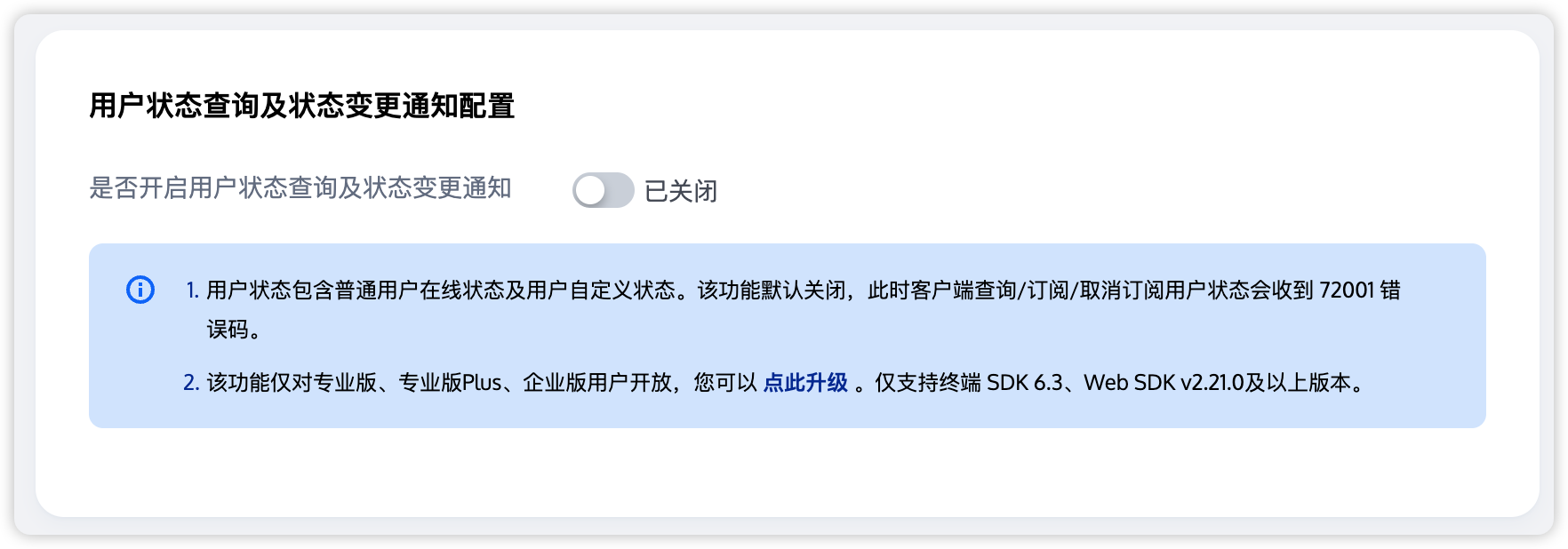
注意:
订阅用户状态需要升级到专业版套餐,详情请参见 基础服务详情。
订阅用户状态需要提前在 Chat 控制台 开启 用户状态查询及状态变更通知配置,如果未开启则调用
subscribeUserStatus 会报错。服务端踢人及解散房间
1. 服务端踢人。
首先调用 RTC Engine 服务端踢人接口 RemoveUser(整型房间号)或 RemoveUserByStrRoomId(字符串房间号)将目标用户踢出 RTC Engine 房间,输入示例如下:
https://trtc.tencentcloudapi.com/?Action=RemoveUser&SdkAppId=1400000001&RoomId=1234&UserIds.0=test1&UserIds.1=test2&<公共请求参数>
执行踢人成功后,目标用户在客户端会收到
onExitRoom() 回调,且 reason 值为1。此时您可以在该回调中处理下麦、退出 Chat 群组等操作。// 离开 TRTC 房间事件回调- (void)onExitRoom:(NSInteger)reason {if (reason == 0) {// 主动调用 exitRoom 退出房间NSLog(@"Exit current room by calling the 'exitRoom' api of sdk ...");} else {// reason 1: 被服务器踢出当前房间// reason 2: 当前房间被整个解散NSLog(@"Kicked out of the current room by server or current room is dissolved ...");// 下麦[self leaveSeatWithIndex:seatIndex];// 退出 Chat 群组[[V2TIMManager sharedInstance] quitGroup:groupID succ:^{// 退出群组成功} fail:^(int code, NSString *desc) {// 退出群组失败}];}}
2. 服务端解散房间。
https://xxxxxx/v4/group_open_http_svc/destroy_group?sdkappid=88888888&identifier=admin&usersig=xxx&random=99999999&contenttype=json
执行解散群组成功后,目标群组内的全部成员在客户端均会收到
onGroupDismissed() 回调。此时您可以在该回调中处理退出 RTC Engine 房间等操作。// 群组被解散回调[[V2TIMManager sharedInstance] addGroupListener:self];- (void)onGroupDismissed:(NSString *)groupID opUser:(V2TIMGroupMemberInfo *)opUser {// 退出 TRTC 房间[self.trtcCloud stopLocalAudio];[self.trtcCloud exitRoom];}
说明:
当房间内所有用户调用
exitRoom() 完成退房后,RTC Engine 房间会自动解散。当然,您也可以调用服务端接口 DismissRoom(整型房间号)或 DismissRoomByStrRoomId(字符串房间号)强制解散 RTC Engine 房间。进房查看直播间历史消息
使用 AVChatRoom 默认不存储直播间历史消息,当新用户进入直播间后,只能看到进入直播间后用户发送的消息。为了优化新进群用户的体验,可在控制台配置直播群用户拉取进群前消息条数,如图:
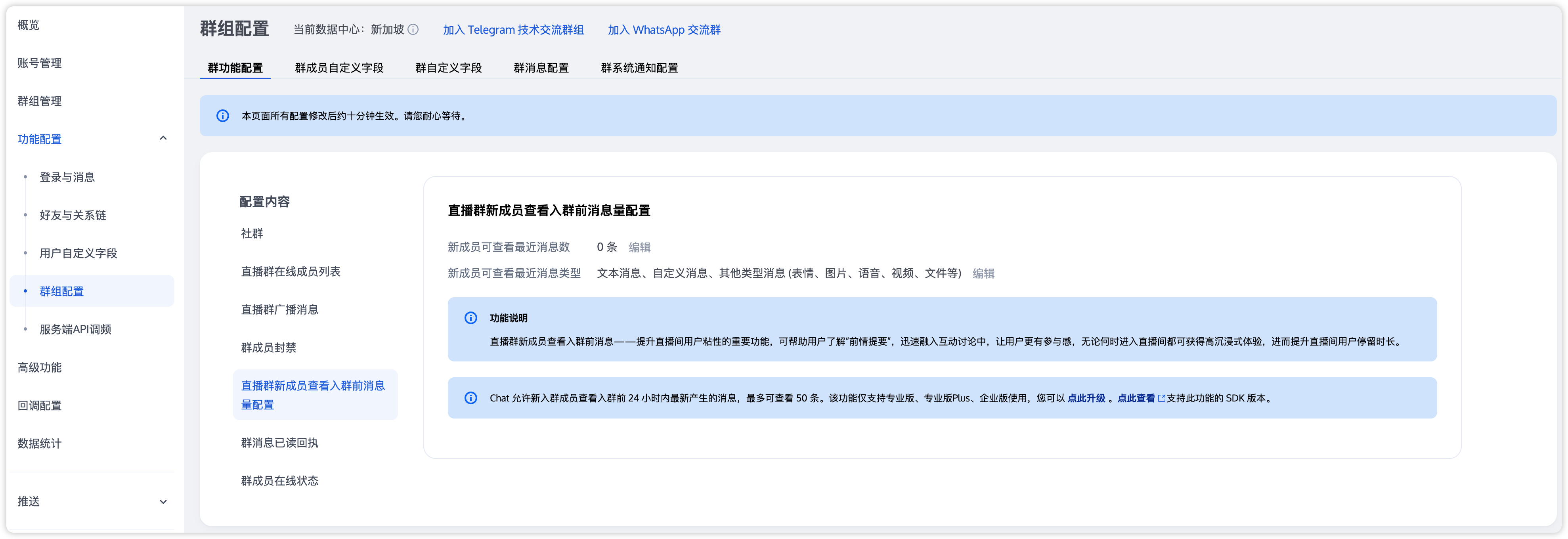
直播群用户拉取进群前历史消息与拉起其他群历史消息一样,代码示例:
V2TIMMessageListGetOption *option = [[V2TIMMessageListGetOption alloc] init];option.getType = V2TIM_GET_CLOUD_OLDER_MSG; // 拉取云端的更老的消息option.getTimeBegin = 1640966400; // 从 2022-01-01 00:00:00 开始option.getTimePeriod = 1 * 24 * 60 * 60; // 拉取一整天的消息option.count = INT_MAX; // 返回时间范围内所有的消息option.groupID = #your group id#; // 拉取群聊消息[V2TIMManager.sharedInstance getHistoryMessageList:option succ:^(NSArray<V2TIMMessage *> *msgs) {NSLog(@"success");} fail:^(int code, NSString *desc) {NSLog(@"failure, code:%d, desc:%@", code, desc);}];
注意:
此功能仅限进阶版用户才可开通,且仅支持拉群24小时内最多20条历史消息。
进房感知麦上主播静音状态
方案一:进房时默认所有主播为静音状态,然后根据
onUserAudioAvailable(userId, true) 回调解除对应主播禁音状态。- (void)onUserAudioAvailable:(NSString *)userId available:(BOOL)available {if (available) {// 解除对应主播的禁音状态}}
方案二:把主播的静音状态存储在 Chat 群属性中,听众进房获取全量群属性,解析麦上主播禁音状态。
[[V2TIMManager sharedInstance] getGroupAttributes:groupID keys:nil succ:^(NSMutableDictionary<NSString *,NSString *> *groupAttributeList) {// 获取群属性成功,假设存储主播静音状态的 key 为 muteStatusNSString *muteStatus = groupAttributeList[@"muteStatus"];// 解析 muteStatus,获取每个麦上主播的禁音状态} fail:^(int code, NSString *desc) {// 获取群属性失败}];
文档反馈

